Management Accounting Report: Tesco's Financial Strategies
VerifiedAdded on 2020/12/09
|16
|3509
|245
Report
AI Summary
This report provides a comprehensive analysis of management accounting within Tesco, a multinational supermarket retailer. It delves into the core principles of management accounting, its role in decision-making, and the application of various tools and techniques. The report examines planning tools like cash flow statements, CVP analysis, and cash forecasting budgets, evaluating their advantages and disadvantages. Furthermore, it explores how Tesco responds to financial problems through inventory management, pricing strategies, and cash flow forecasting. Financial statement analysis, including profitability ratios, is used to assess Tesco's financial performance and provide insights into its effectiveness in addressing financial challenges. The report highlights the importance of management accounting in formulating strategies to enhance productivity, profitability, and stability within the organization.
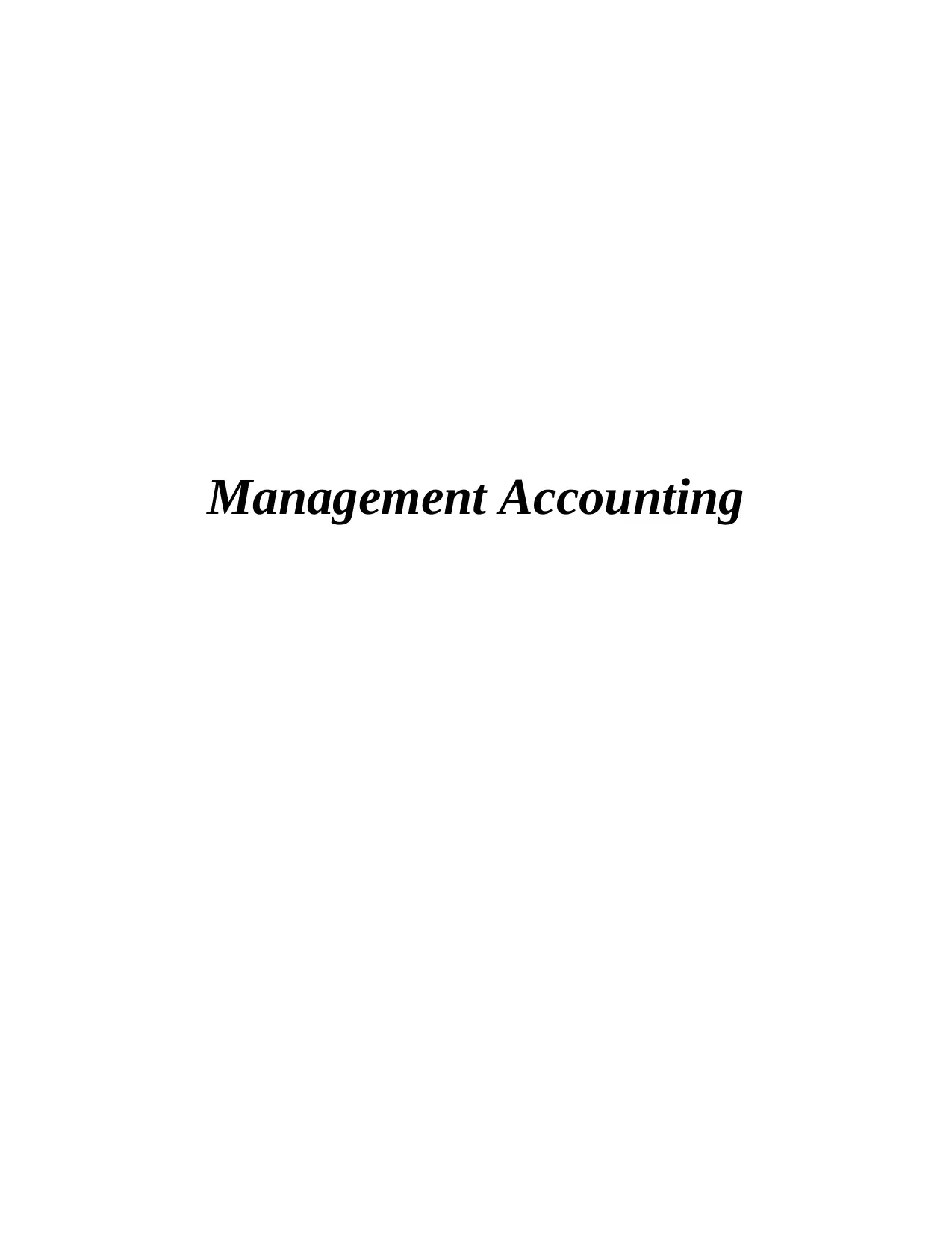
Management Accounting
Paraphrase This Document
Need a fresh take? Get an instant paraphrase of this document with our AI Paraphraser
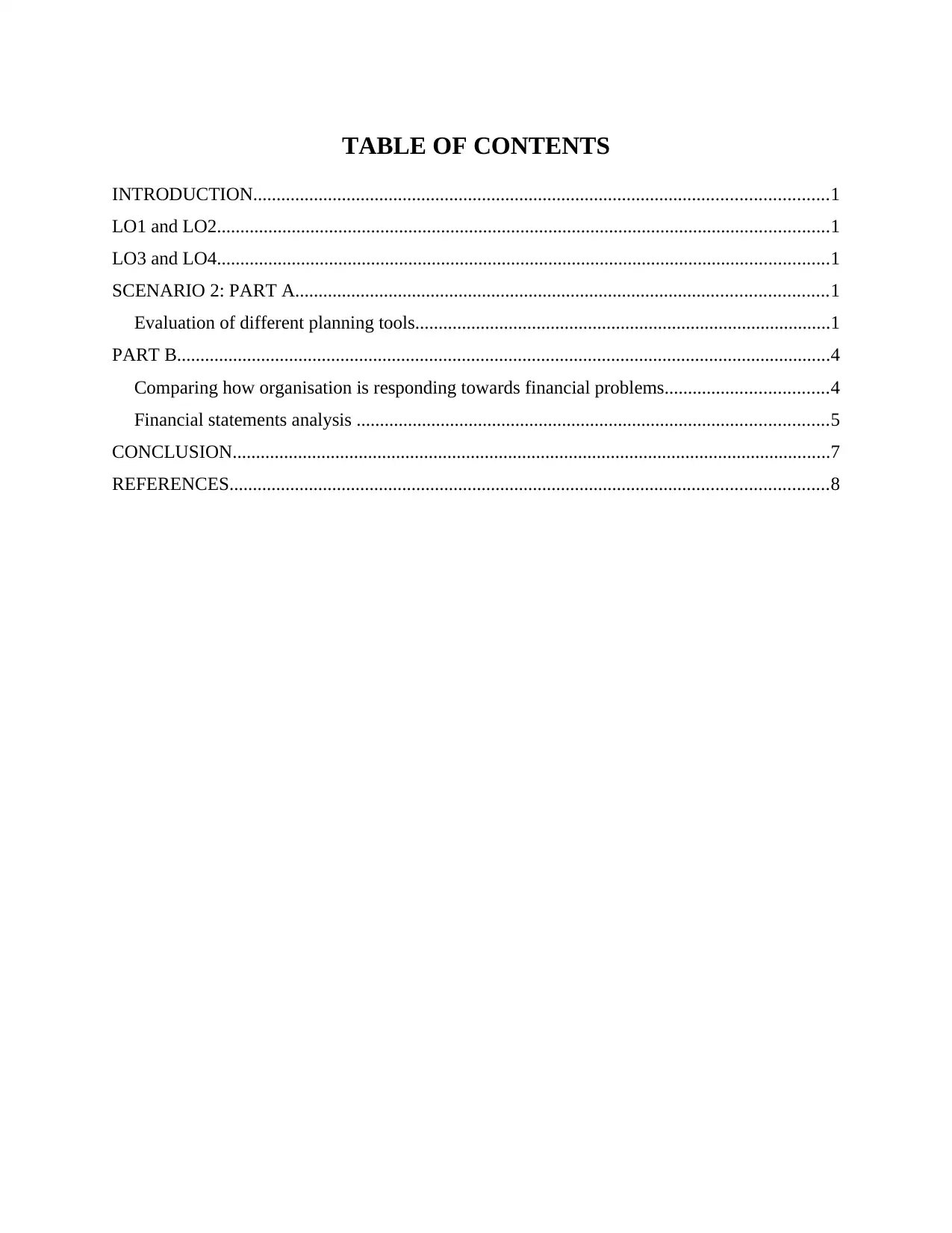
TABLE OF CONTENTS
INTRODUCTION...........................................................................................................................1
LO1 and LO2...................................................................................................................................1
LO3 and LO4...................................................................................................................................1
SCENARIO 2: PART A..................................................................................................................1
Evaluation of different planning tools.........................................................................................1
PART B............................................................................................................................................4
Comparing how organisation is responding towards financial problems...................................4
Financial statements analysis .....................................................................................................5
CONCLUSION................................................................................................................................7
REFERENCES................................................................................................................................8
INTRODUCTION...........................................................................................................................1
LO1 and LO2...................................................................................................................................1
LO3 and LO4...................................................................................................................................1
SCENARIO 2: PART A..................................................................................................................1
Evaluation of different planning tools.........................................................................................1
PART B............................................................................................................................................4
Comparing how organisation is responding towards financial problems...................................4
Financial statements analysis .....................................................................................................5
CONCLUSION................................................................................................................................7
REFERENCES................................................................................................................................8
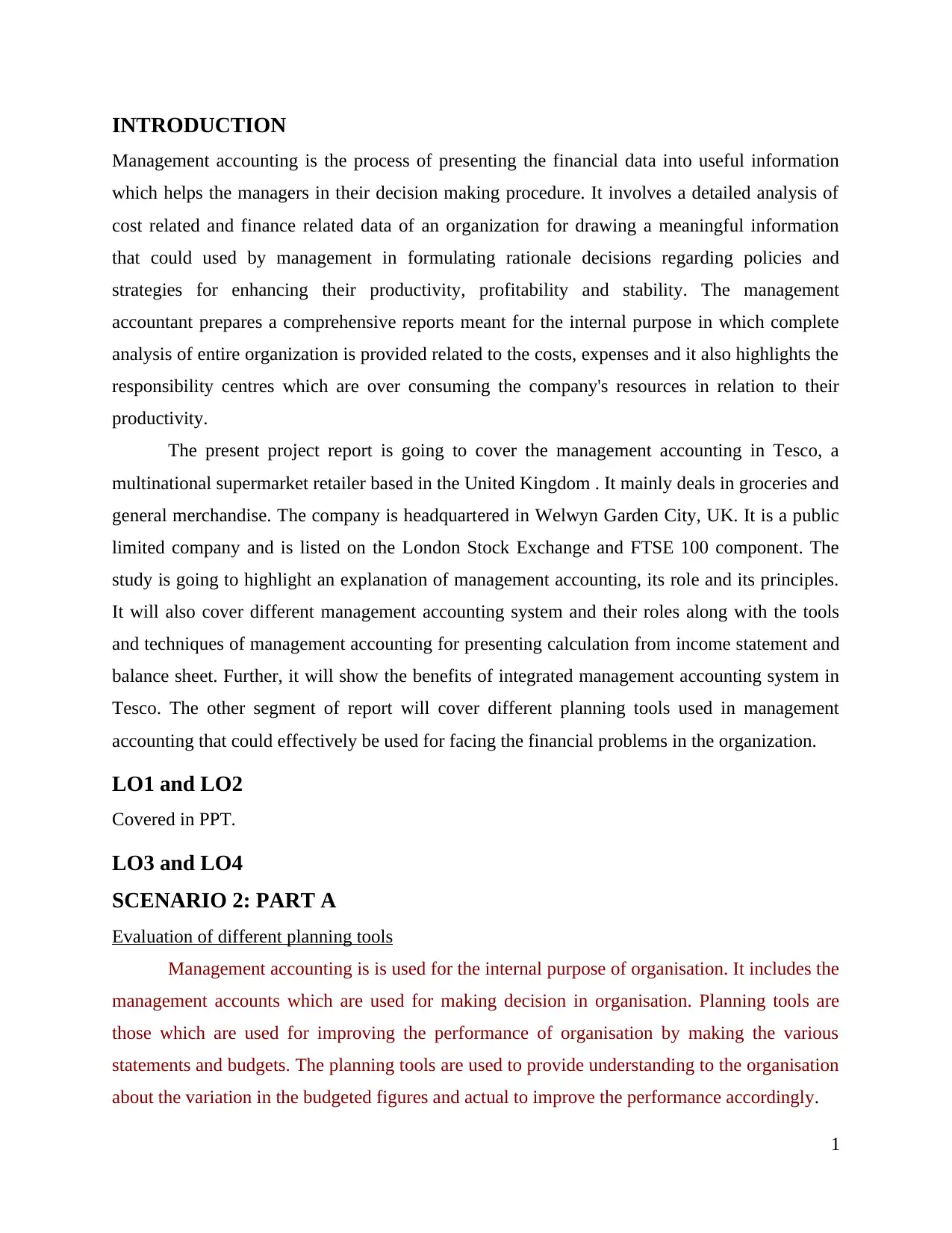
INTRODUCTION
Management accounting is the process of presenting the financial data into useful information
which helps the managers in their decision making procedure. It involves a detailed analysis of
cost related and finance related data of an organization for drawing a meaningful information
that could used by management in formulating rationale decisions regarding policies and
strategies for enhancing their productivity, profitability and stability. The management
accountant prepares a comprehensive reports meant for the internal purpose in which complete
analysis of entire organization is provided related to the costs, expenses and it also highlights the
responsibility centres which are over consuming the company's resources in relation to their
productivity.
The present project report is going to cover the management accounting in Tesco, a
multinational supermarket retailer based in the United Kingdom . It mainly deals in groceries and
general merchandise. The company is headquartered in Welwyn Garden City, UK. It is a public
limited company and is listed on the London Stock Exchange and FTSE 100 component. The
study is going to highlight an explanation of management accounting, its role and its principles.
It will also cover different management accounting system and their roles along with the tools
and techniques of management accounting for presenting calculation from income statement and
balance sheet. Further, it will show the benefits of integrated management accounting system in
Tesco. The other segment of report will cover different planning tools used in management
accounting that could effectively be used for facing the financial problems in the organization.
LO1 and LO2
Covered in PPT.
LO3 and LO4
SCENARIO 2: PART A
Evaluation of different planning tools
Management accounting is is used for the internal purpose of organisation. It includes the
management accounts which are used for making decision in organisation. Planning tools are
those which are used for improving the performance of organisation by making the various
statements and budgets. The planning tools are used to provide understanding to the organisation
about the variation in the budgeted figures and actual to improve the performance accordingly.
1
Management accounting is the process of presenting the financial data into useful information
which helps the managers in their decision making procedure. It involves a detailed analysis of
cost related and finance related data of an organization for drawing a meaningful information
that could used by management in formulating rationale decisions regarding policies and
strategies for enhancing their productivity, profitability and stability. The management
accountant prepares a comprehensive reports meant for the internal purpose in which complete
analysis of entire organization is provided related to the costs, expenses and it also highlights the
responsibility centres which are over consuming the company's resources in relation to their
productivity.
The present project report is going to cover the management accounting in Tesco, a
multinational supermarket retailer based in the United Kingdom . It mainly deals in groceries and
general merchandise. The company is headquartered in Welwyn Garden City, UK. It is a public
limited company and is listed on the London Stock Exchange and FTSE 100 component. The
study is going to highlight an explanation of management accounting, its role and its principles.
It will also cover different management accounting system and their roles along with the tools
and techniques of management accounting for presenting calculation from income statement and
balance sheet. Further, it will show the benefits of integrated management accounting system in
Tesco. The other segment of report will cover different planning tools used in management
accounting that could effectively be used for facing the financial problems in the organization.
LO1 and LO2
Covered in PPT.
LO3 and LO4
SCENARIO 2: PART A
Evaluation of different planning tools
Management accounting is is used for the internal purpose of organisation. It includes the
management accounts which are used for making decision in organisation. Planning tools are
those which are used for improving the performance of organisation by making the various
statements and budgets. The planning tools are used to provide understanding to the organisation
about the variation in the budgeted figures and actual to improve the performance accordingly.
1
⊘ This is a preview!⊘
Do you want full access?
Subscribe today to unlock all pages.

Trusted by 1+ million students worldwide
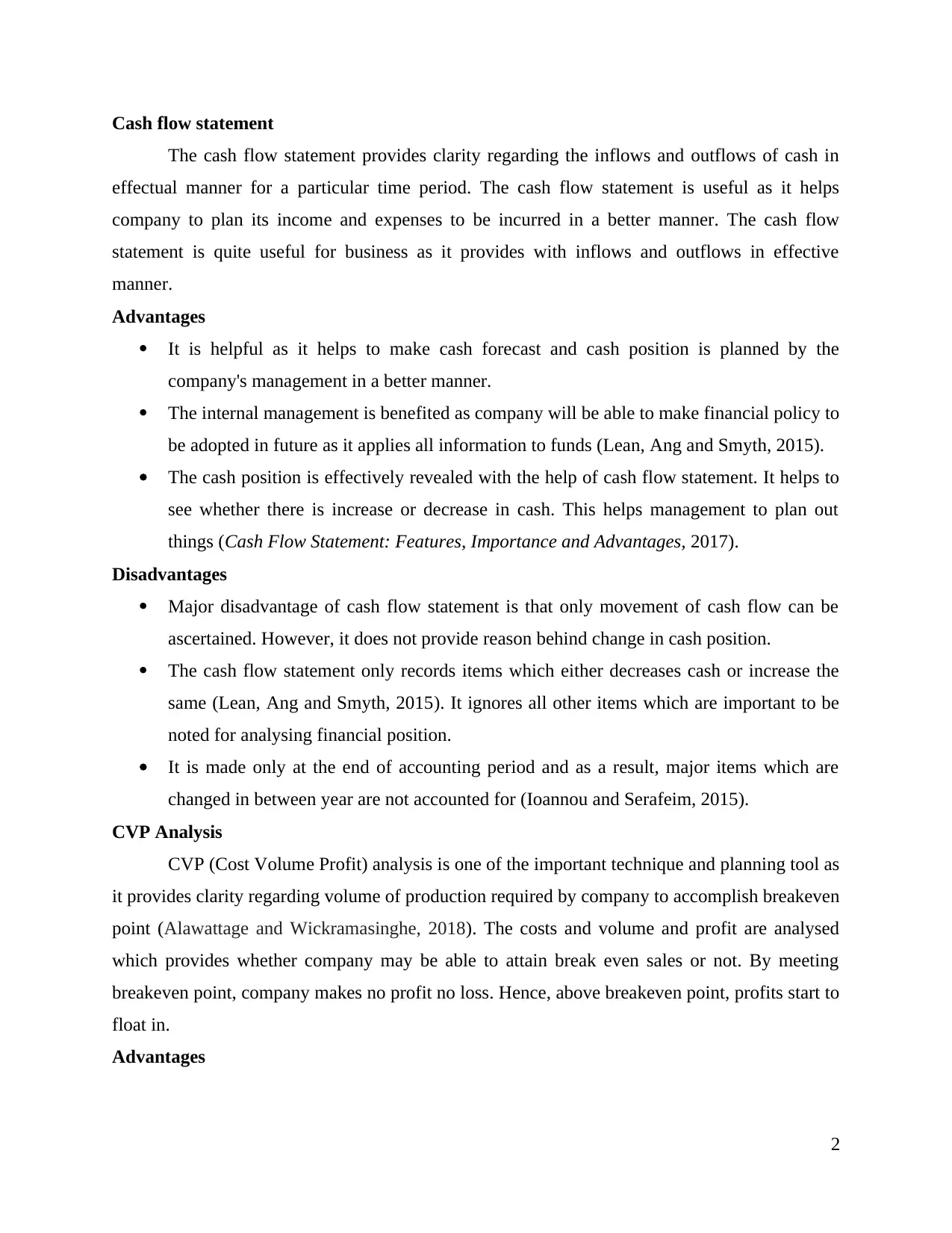
Cash flow statement
The cash flow statement provides clarity regarding the inflows and outflows of cash in
effectual manner for a particular time period. The cash flow statement is useful as it helps
company to plan its income and expenses to be incurred in a better manner. The cash flow
statement is quite useful for business as it provides with inflows and outflows in effective
manner.
Advantages
It is helpful as it helps to make cash forecast and cash position is planned by the
company's management in a better manner.
The internal management is benefited as company will be able to make financial policy to
be adopted in future as it applies all information to funds (Lean, Ang and Smyth, 2015).
The cash position is effectively revealed with the help of cash flow statement. It helps to
see whether there is increase or decrease in cash. This helps management to plan out
things (Cash Flow Statement: Features, Importance and Advantages, 2017).
Disadvantages
Major disadvantage of cash flow statement is that only movement of cash flow can be
ascertained. However, it does not provide reason behind change in cash position.
The cash flow statement only records items which either decreases cash or increase the
same (Lean, Ang and Smyth, 2015). It ignores all other items which are important to be
noted for analysing financial position.
It is made only at the end of accounting period and as a result, major items which are
changed in between year are not accounted for (Ioannou and Serafeim, 2015).
CVP Analysis
CVP (Cost Volume Profit) analysis is one of the important technique and planning tool as
it provides clarity regarding volume of production required by company to accomplish breakeven
point (Alawattage and Wickramasinghe, 2018). The costs and volume and profit are analysed
which provides whether company may be able to attain break even sales or not. By meeting
breakeven point, company makes no profit no loss. Hence, above breakeven point, profits start to
float in.
Advantages
2
The cash flow statement provides clarity regarding the inflows and outflows of cash in
effectual manner for a particular time period. The cash flow statement is useful as it helps
company to plan its income and expenses to be incurred in a better manner. The cash flow
statement is quite useful for business as it provides with inflows and outflows in effective
manner.
Advantages
It is helpful as it helps to make cash forecast and cash position is planned by the
company's management in a better manner.
The internal management is benefited as company will be able to make financial policy to
be adopted in future as it applies all information to funds (Lean, Ang and Smyth, 2015).
The cash position is effectively revealed with the help of cash flow statement. It helps to
see whether there is increase or decrease in cash. This helps management to plan out
things (Cash Flow Statement: Features, Importance and Advantages, 2017).
Disadvantages
Major disadvantage of cash flow statement is that only movement of cash flow can be
ascertained. However, it does not provide reason behind change in cash position.
The cash flow statement only records items which either decreases cash or increase the
same (Lean, Ang and Smyth, 2015). It ignores all other items which are important to be
noted for analysing financial position.
It is made only at the end of accounting period and as a result, major items which are
changed in between year are not accounted for (Ioannou and Serafeim, 2015).
CVP Analysis
CVP (Cost Volume Profit) analysis is one of the important technique and planning tool as
it provides clarity regarding volume of production required by company to accomplish breakeven
point (Alawattage and Wickramasinghe, 2018). The costs and volume and profit are analysed
which provides whether company may be able to attain break even sales or not. By meeting
breakeven point, company makes no profit no loss. Hence, above breakeven point, profits start to
float in.
Advantages
2
Paraphrase This Document
Need a fresh take? Get an instant paraphrase of this document with our AI Paraphraser
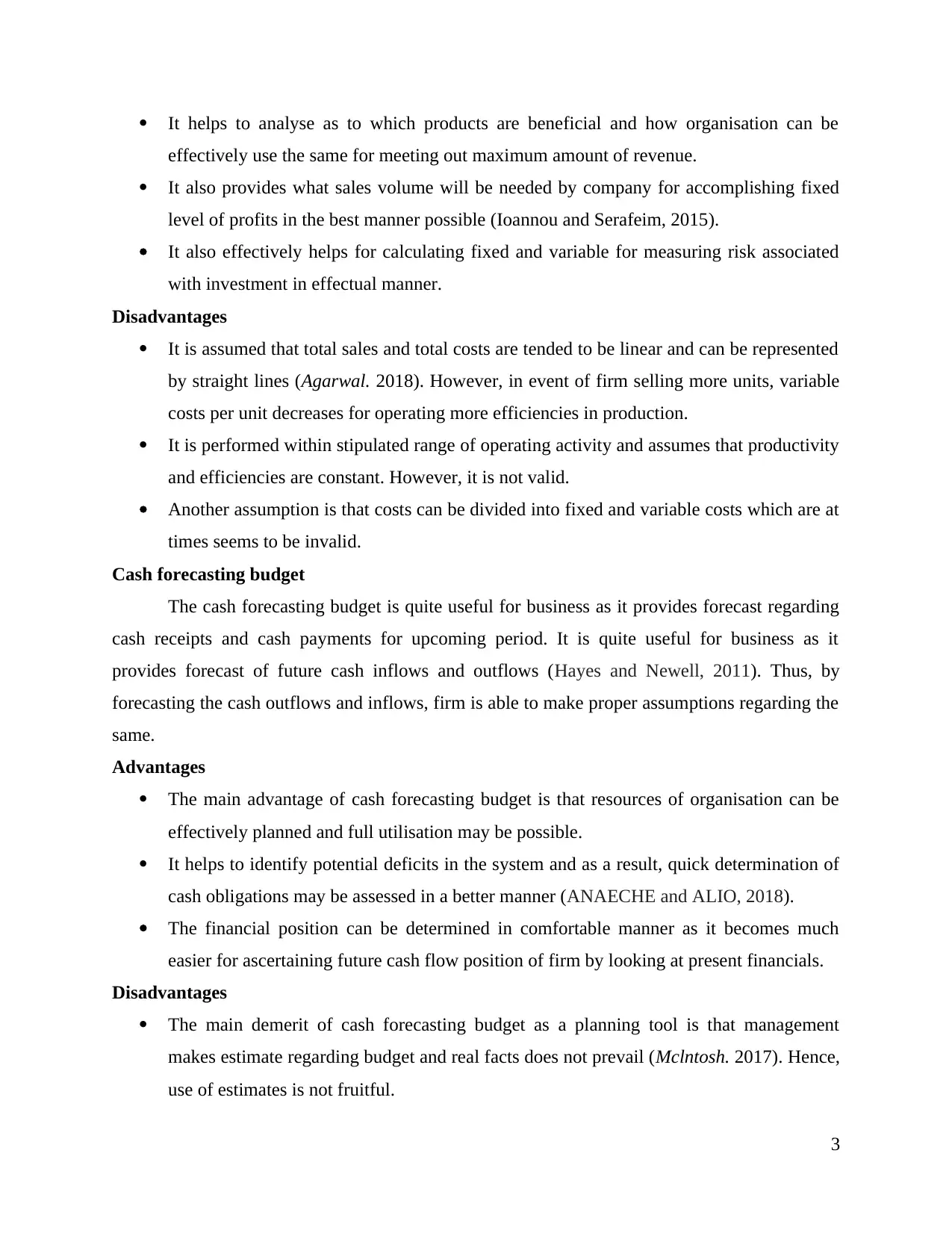
It helps to analyse as to which products are beneficial and how organisation can be
effectively use the same for meeting out maximum amount of revenue.
It also provides what sales volume will be needed by company for accomplishing fixed
level of profits in the best manner possible (Ioannou and Serafeim, 2015).
It also effectively helps for calculating fixed and variable for measuring risk associated
with investment in effectual manner.
Disadvantages
It is assumed that total sales and total costs are tended to be linear and can be represented
by straight lines (Agarwal. 2018). However, in event of firm selling more units, variable
costs per unit decreases for operating more efficiencies in production.
It is performed within stipulated range of operating activity and assumes that productivity
and efficiencies are constant. However, it is not valid.
Another assumption is that costs can be divided into fixed and variable costs which are at
times seems to be invalid.
Cash forecasting budget
The cash forecasting budget is quite useful for business as it provides forecast regarding
cash receipts and cash payments for upcoming period. It is quite useful for business as it
provides forecast of future cash inflows and outflows (Hayes and Newell, 2011). Thus, by
forecasting the cash outflows and inflows, firm is able to make proper assumptions regarding the
same.
Advantages
The main advantage of cash forecasting budget is that resources of organisation can be
effectively planned and full utilisation may be possible.
It helps to identify potential deficits in the system and as a result, quick determination of
cash obligations may be assessed in a better manner (ANAECHE and ALIO, 2018).
The financial position can be determined in comfortable manner as it becomes much
easier for ascertaining future cash flow position of firm by looking at present financials.
Disadvantages
The main demerit of cash forecasting budget as a planning tool is that management
makes estimate regarding budget and real facts does not prevail (Mclntosh. 2017). Hence,
use of estimates is not fruitful.
3
effectively use the same for meeting out maximum amount of revenue.
It also provides what sales volume will be needed by company for accomplishing fixed
level of profits in the best manner possible (Ioannou and Serafeim, 2015).
It also effectively helps for calculating fixed and variable for measuring risk associated
with investment in effectual manner.
Disadvantages
It is assumed that total sales and total costs are tended to be linear and can be represented
by straight lines (Agarwal. 2018). However, in event of firm selling more units, variable
costs per unit decreases for operating more efficiencies in production.
It is performed within stipulated range of operating activity and assumes that productivity
and efficiencies are constant. However, it is not valid.
Another assumption is that costs can be divided into fixed and variable costs which are at
times seems to be invalid.
Cash forecasting budget
The cash forecasting budget is quite useful for business as it provides forecast regarding
cash receipts and cash payments for upcoming period. It is quite useful for business as it
provides forecast of future cash inflows and outflows (Hayes and Newell, 2011). Thus, by
forecasting the cash outflows and inflows, firm is able to make proper assumptions regarding the
same.
Advantages
The main advantage of cash forecasting budget is that resources of organisation can be
effectively planned and full utilisation may be possible.
It helps to identify potential deficits in the system and as a result, quick determination of
cash obligations may be assessed in a better manner (ANAECHE and ALIO, 2018).
The financial position can be determined in comfortable manner as it becomes much
easier for ascertaining future cash flow position of firm by looking at present financials.
Disadvantages
The main demerit of cash forecasting budget as a planning tool is that management
makes estimate regarding budget and real facts does not prevail (Mclntosh. 2017). Hence,
use of estimates is not fruitful.
3
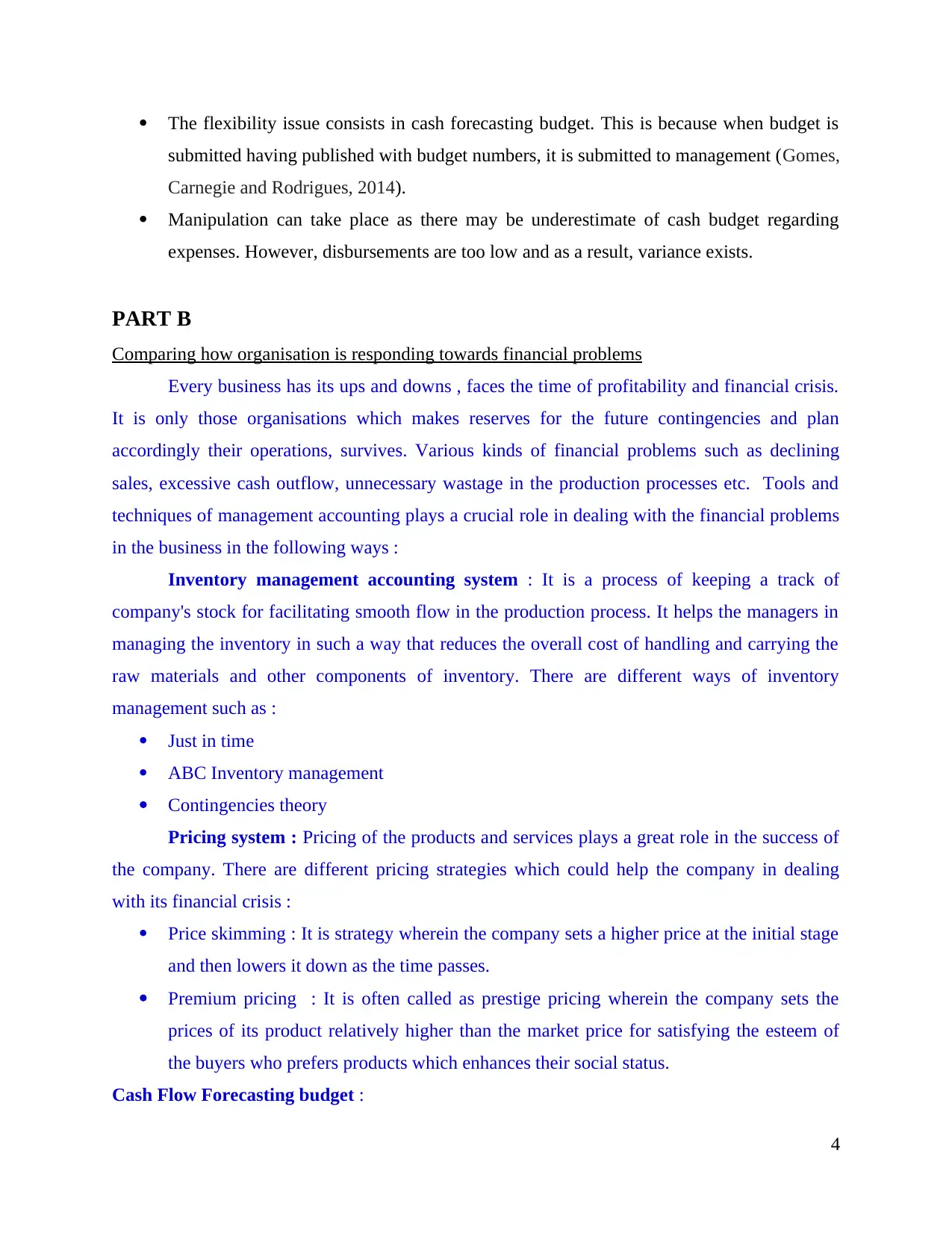
The flexibility issue consists in cash forecasting budget. This is because when budget is
submitted having published with budget numbers, it is submitted to management (Gomes,
Carnegie and Rodrigues, 2014).
Manipulation can take place as there may be underestimate of cash budget regarding
expenses. However, disbursements are too low and as a result, variance exists.
PART B
Comparing how organisation is responding towards financial problems
Every business has its ups and downs , faces the time of profitability and financial crisis.
It is only those organisations which makes reserves for the future contingencies and plan
accordingly their operations, survives. Various kinds of financial problems such as declining
sales, excessive cash outflow, unnecessary wastage in the production processes etc. Tools and
techniques of management accounting plays a crucial role in dealing with the financial problems
in the business in the following ways :
Inventory management accounting system : It is a process of keeping a track of
company's stock for facilitating smooth flow in the production process. It helps the managers in
managing the inventory in such a way that reduces the overall cost of handling and carrying the
raw materials and other components of inventory. There are different ways of inventory
management such as :
Just in time
ABC Inventory management
Contingencies theory
Pricing system : Pricing of the products and services plays a great role in the success of
the company. There are different pricing strategies which could help the company in dealing
with its financial crisis :
Price skimming : It is strategy wherein the company sets a higher price at the initial stage
and then lowers it down as the time passes.
Premium pricing : It is often called as prestige pricing wherein the company sets the
prices of its product relatively higher than the market price for satisfying the esteem of
the buyers who prefers products which enhances their social status.
Cash Flow Forecasting budget :
4
submitted having published with budget numbers, it is submitted to management (Gomes,
Carnegie and Rodrigues, 2014).
Manipulation can take place as there may be underestimate of cash budget regarding
expenses. However, disbursements are too low and as a result, variance exists.
PART B
Comparing how organisation is responding towards financial problems
Every business has its ups and downs , faces the time of profitability and financial crisis.
It is only those organisations which makes reserves for the future contingencies and plan
accordingly their operations, survives. Various kinds of financial problems such as declining
sales, excessive cash outflow, unnecessary wastage in the production processes etc. Tools and
techniques of management accounting plays a crucial role in dealing with the financial problems
in the business in the following ways :
Inventory management accounting system : It is a process of keeping a track of
company's stock for facilitating smooth flow in the production process. It helps the managers in
managing the inventory in such a way that reduces the overall cost of handling and carrying the
raw materials and other components of inventory. There are different ways of inventory
management such as :
Just in time
ABC Inventory management
Contingencies theory
Pricing system : Pricing of the products and services plays a great role in the success of
the company. There are different pricing strategies which could help the company in dealing
with its financial crisis :
Price skimming : It is strategy wherein the company sets a higher price at the initial stage
and then lowers it down as the time passes.
Premium pricing : It is often called as prestige pricing wherein the company sets the
prices of its product relatively higher than the market price for satisfying the esteem of
the buyers who prefers products which enhances their social status.
Cash Flow Forecasting budget :
4
⊘ This is a preview!⊘
Do you want full access?
Subscribe today to unlock all pages.

Trusted by 1+ million students worldwide
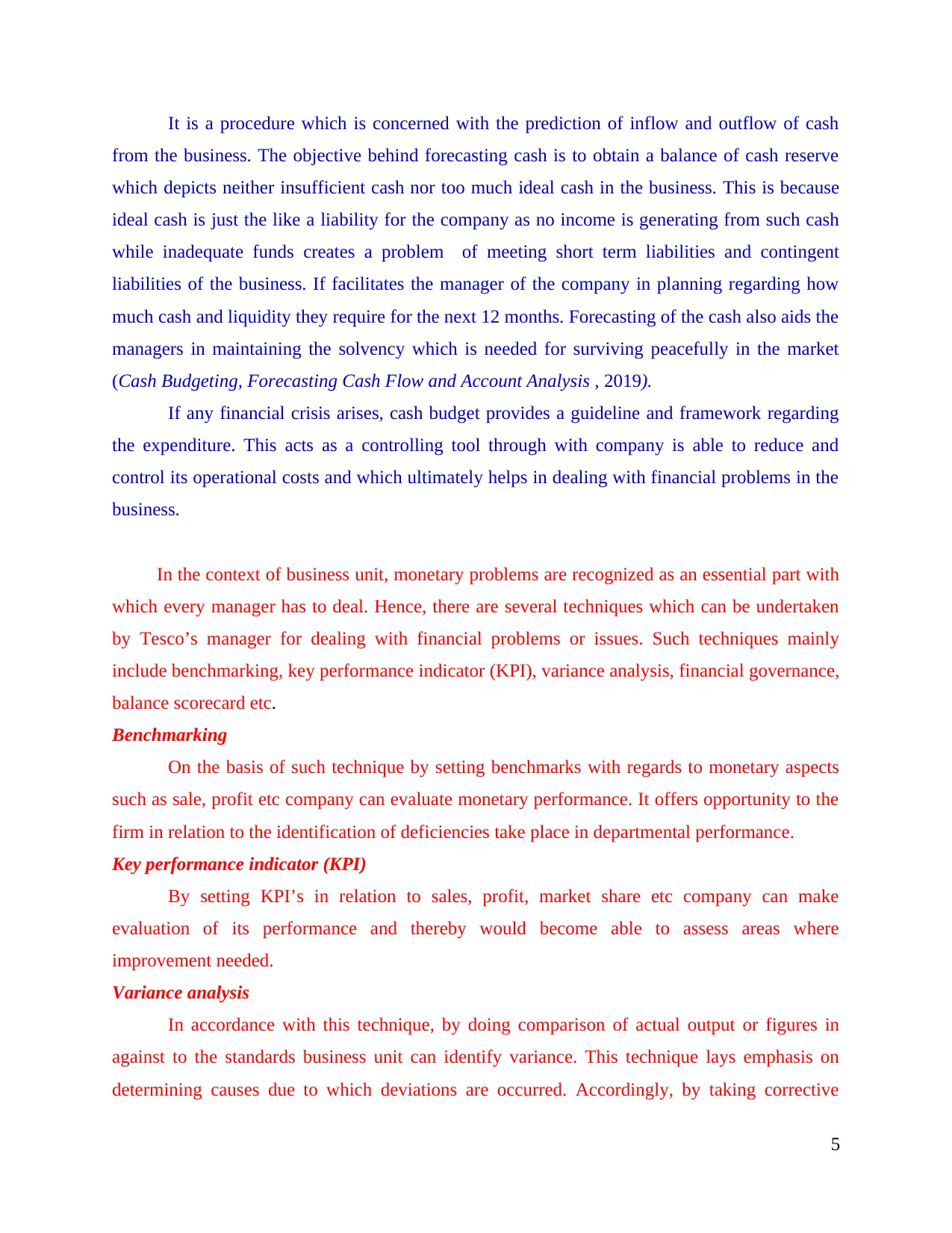
It is a procedure which is concerned with the prediction of inflow and outflow of cash
from the business. The objective behind forecasting cash is to obtain a balance of cash reserve
which depicts neither insufficient cash nor too much ideal cash in the business. This is because
ideal cash is just the like a liability for the company as no income is generating from such cash
while inadequate funds creates a problem of meeting short term liabilities and contingent
liabilities of the business. If facilitates the manager of the company in planning regarding how
much cash and liquidity they require for the next 12 months. Forecasting of the cash also aids the
managers in maintaining the solvency which is needed for surviving peacefully in the market
(Cash Budgeting, Forecasting Cash Flow and Account Analysis , 2019).
If any financial crisis arises, cash budget provides a guideline and framework regarding
the expenditure. This acts as a controlling tool through with company is able to reduce and
control its operational costs and which ultimately helps in dealing with financial problems in the
business.
In the context of business unit, monetary problems are recognized as an essential part with
which every manager has to deal. Hence, there are several techniques which can be undertaken
by Tesco’s manager for dealing with financial problems or issues. Such techniques mainly
include benchmarking, key performance indicator (KPI), variance analysis, financial governance,
balance scorecard etc.
Benchmarking
On the basis of such technique by setting benchmarks with regards to monetary aspects
such as sale, profit etc company can evaluate monetary performance. It offers opportunity to the
firm in relation to the identification of deficiencies take place in departmental performance.
Key performance indicator (KPI)
By setting KPI’s in relation to sales, profit, market share etc company can make
evaluation of its performance and thereby would become able to assess areas where
improvement needed.
Variance analysis
In accordance with this technique, by doing comparison of actual output or figures in
against to the standards business unit can identify variance. This technique lays emphasis on
determining causes due to which deviations are occurred. Accordingly, by taking corrective
5
from the business. The objective behind forecasting cash is to obtain a balance of cash reserve
which depicts neither insufficient cash nor too much ideal cash in the business. This is because
ideal cash is just the like a liability for the company as no income is generating from such cash
while inadequate funds creates a problem of meeting short term liabilities and contingent
liabilities of the business. If facilitates the manager of the company in planning regarding how
much cash and liquidity they require for the next 12 months. Forecasting of the cash also aids the
managers in maintaining the solvency which is needed for surviving peacefully in the market
(Cash Budgeting, Forecasting Cash Flow and Account Analysis , 2019).
If any financial crisis arises, cash budget provides a guideline and framework regarding
the expenditure. This acts as a controlling tool through with company is able to reduce and
control its operational costs and which ultimately helps in dealing with financial problems in the
business.
In the context of business unit, monetary problems are recognized as an essential part with
which every manager has to deal. Hence, there are several techniques which can be undertaken
by Tesco’s manager for dealing with financial problems or issues. Such techniques mainly
include benchmarking, key performance indicator (KPI), variance analysis, financial governance,
balance scorecard etc.
Benchmarking
On the basis of such technique by setting benchmarks with regards to monetary aspects
such as sale, profit etc company can evaluate monetary performance. It offers opportunity to the
firm in relation to the identification of deficiencies take place in departmental performance.
Key performance indicator (KPI)
By setting KPI’s in relation to sales, profit, market share etc company can make
evaluation of its performance and thereby would become able to assess areas where
improvement needed.
Variance analysis
In accordance with this technique, by doing comparison of actual output or figures in
against to the standards business unit can identify variance. This technique lays emphasis on
determining causes due to which deviations are occurred. Accordingly, by taking corrective
5
Paraphrase This Document
Need a fresh take? Get an instant paraphrase of this document with our AI Paraphraser
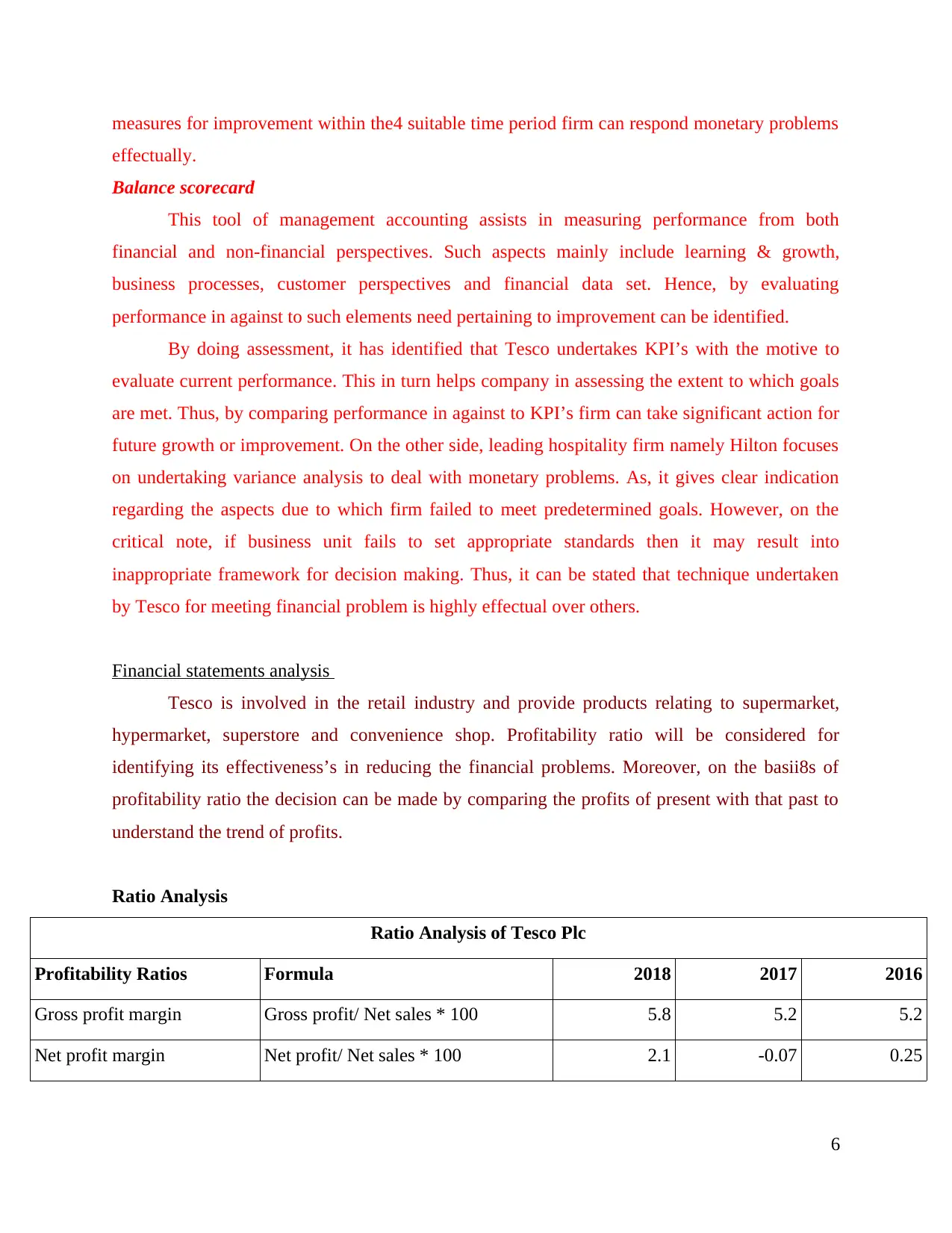
measures for improvement within the4 suitable time period firm can respond monetary problems
effectually.
Balance scorecard
This tool of management accounting assists in measuring performance from both
financial and non-financial perspectives. Such aspects mainly include learning & growth,
business processes, customer perspectives and financial data set. Hence, by evaluating
performance in against to such elements need pertaining to improvement can be identified.
By doing assessment, it has identified that Tesco undertakes KPI’s with the motive to
evaluate current performance. This in turn helps company in assessing the extent to which goals
are met. Thus, by comparing performance in against to KPI’s firm can take significant action for
future growth or improvement. On the other side, leading hospitality firm namely Hilton focuses
on undertaking variance analysis to deal with monetary problems. As, it gives clear indication
regarding the aspects due to which firm failed to meet predetermined goals. However, on the
critical note, if business unit fails to set appropriate standards then it may result into
inappropriate framework for decision making. Thus, it can be stated that technique undertaken
by Tesco for meeting financial problem is highly effectual over others.
Financial statements analysis
Tesco is involved in the retail industry and provide products relating to supermarket,
hypermarket, superstore and convenience shop. Profitability ratio will be considered for
identifying its effectiveness’s in reducing the financial problems. Moreover, on the basii8s of
profitability ratio the decision can be made by comparing the profits of present with that past to
understand the trend of profits.
Ratio Analysis
Ratio Analysis of Tesco Plc
Profitability Ratios Formula 2018 2017 2016
Gross profit margin Gross profit/ Net sales * 100 5.8 5.2 5.2
Net profit margin Net profit/ Net sales * 100 2.1 -0.07 0.25
6
effectually.
Balance scorecard
This tool of management accounting assists in measuring performance from both
financial and non-financial perspectives. Such aspects mainly include learning & growth,
business processes, customer perspectives and financial data set. Hence, by evaluating
performance in against to such elements need pertaining to improvement can be identified.
By doing assessment, it has identified that Tesco undertakes KPI’s with the motive to
evaluate current performance. This in turn helps company in assessing the extent to which goals
are met. Thus, by comparing performance in against to KPI’s firm can take significant action for
future growth or improvement. On the other side, leading hospitality firm namely Hilton focuses
on undertaking variance analysis to deal with monetary problems. As, it gives clear indication
regarding the aspects due to which firm failed to meet predetermined goals. However, on the
critical note, if business unit fails to set appropriate standards then it may result into
inappropriate framework for decision making. Thus, it can be stated that technique undertaken
by Tesco for meeting financial problem is highly effectual over others.
Financial statements analysis
Tesco is involved in the retail industry and provide products relating to supermarket,
hypermarket, superstore and convenience shop. Profitability ratio will be considered for
identifying its effectiveness’s in reducing the financial problems. Moreover, on the basii8s of
profitability ratio the decision can be made by comparing the profits of present with that past to
understand the trend of profits.
Ratio Analysis
Ratio Analysis of Tesco Plc
Profitability Ratios Formula 2018 2017 2016
Gross profit margin Gross profit/ Net sales * 100 5.8 5.2 5.2
Net profit margin Net profit/ Net sales * 100 2.1 -0.07 0.25
6
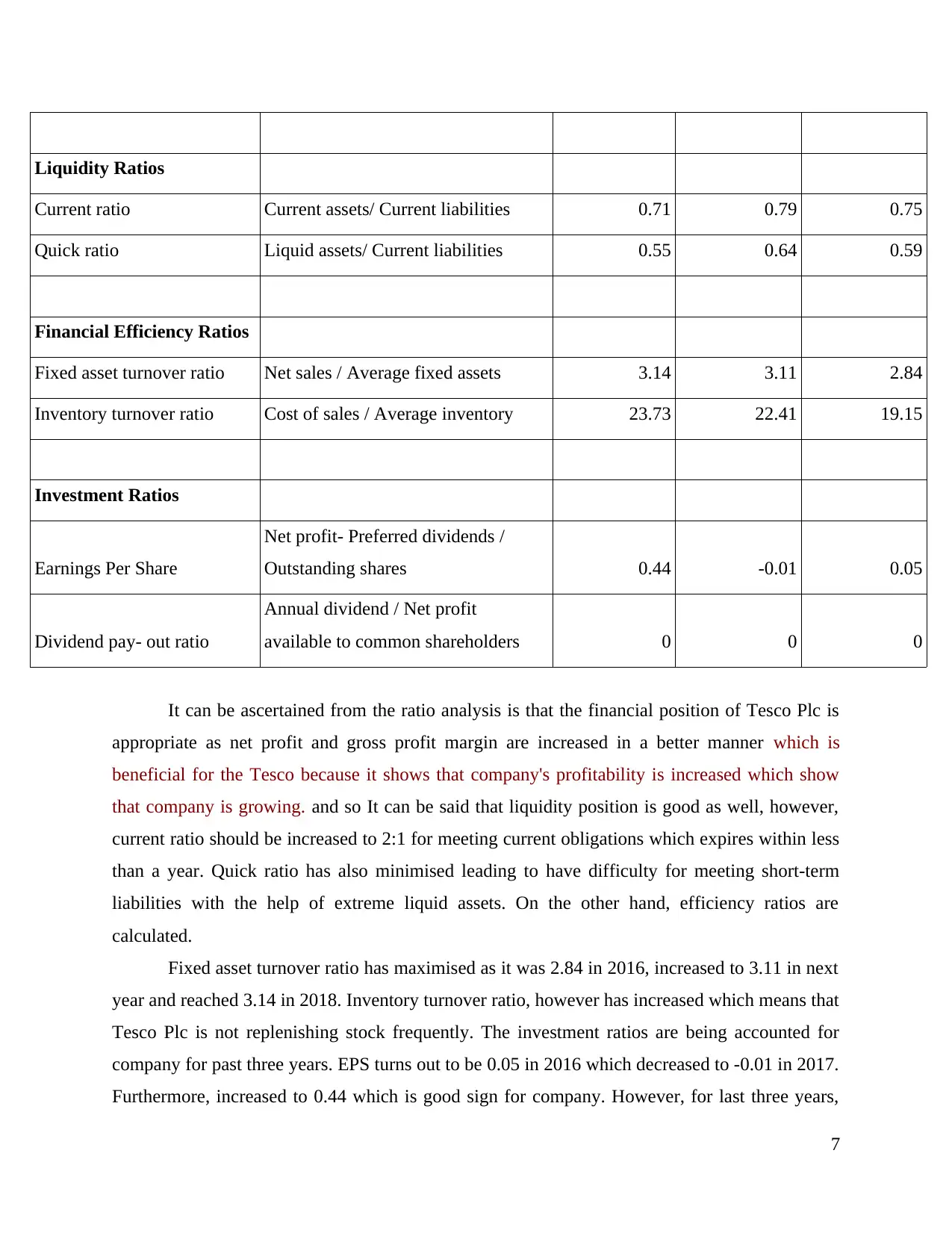
Liquidity Ratios
Current ratio Current assets/ Current liabilities 0.71 0.79 0.75
Quick ratio Liquid assets/ Current liabilities 0.55 0.64 0.59
Financial Efficiency Ratios
Fixed asset turnover ratio Net sales / Average fixed assets 3.14 3.11 2.84
Inventory turnover ratio Cost of sales / Average inventory 23.73 22.41 19.15
Investment Ratios
Earnings Per Share
Net profit- Preferred dividends /
Outstanding shares 0.44 -0.01 0.05
Dividend pay- out ratio
Annual dividend / Net profit
available to common shareholders 0 0 0
It can be ascertained from the ratio analysis is that the financial position of Tesco Plc is
appropriate as net profit and gross profit margin are increased in a better manner which is
beneficial for the Tesco because it shows that company's profitability is increased which show
that company is growing. and so It can be said that liquidity position is good as well, however,
current ratio should be increased to 2:1 for meeting current obligations which expires within less
than a year. Quick ratio has also minimised leading to have difficulty for meeting short-term
liabilities with the help of extreme liquid assets. On the other hand, efficiency ratios are
calculated.
Fixed asset turnover ratio has maximised as it was 2.84 in 2016, increased to 3.11 in next
year and reached 3.14 in 2018. Inventory turnover ratio, however has increased which means that
Tesco Plc is not replenishing stock frequently. The investment ratios are being accounted for
company for past three years. EPS turns out to be 0.05 in 2016 which decreased to -0.01 in 2017.
Furthermore, increased to 0.44 which is good sign for company. However, for last three years,
7
Current ratio Current assets/ Current liabilities 0.71 0.79 0.75
Quick ratio Liquid assets/ Current liabilities 0.55 0.64 0.59
Financial Efficiency Ratios
Fixed asset turnover ratio Net sales / Average fixed assets 3.14 3.11 2.84
Inventory turnover ratio Cost of sales / Average inventory 23.73 22.41 19.15
Investment Ratios
Earnings Per Share
Net profit- Preferred dividends /
Outstanding shares 0.44 -0.01 0.05
Dividend pay- out ratio
Annual dividend / Net profit
available to common shareholders 0 0 0
It can be ascertained from the ratio analysis is that the financial position of Tesco Plc is
appropriate as net profit and gross profit margin are increased in a better manner which is
beneficial for the Tesco because it shows that company's profitability is increased which show
that company is growing. and so It can be said that liquidity position is good as well, however,
current ratio should be increased to 2:1 for meeting current obligations which expires within less
than a year. Quick ratio has also minimised leading to have difficulty for meeting short-term
liabilities with the help of extreme liquid assets. On the other hand, efficiency ratios are
calculated.
Fixed asset turnover ratio has maximised as it was 2.84 in 2016, increased to 3.11 in next
year and reached 3.14 in 2018. Inventory turnover ratio, however has increased which means that
Tesco Plc is not replenishing stock frequently. The investment ratios are being accounted for
company for past three years. EPS turns out to be 0.05 in 2016 which decreased to -0.01 in 2017.
Furthermore, increased to 0.44 which is good sign for company. However, for last three years,
7
⊘ This is a preview!⊘
Do you want full access?
Subscribe today to unlock all pages.

Trusted by 1+ million students worldwide
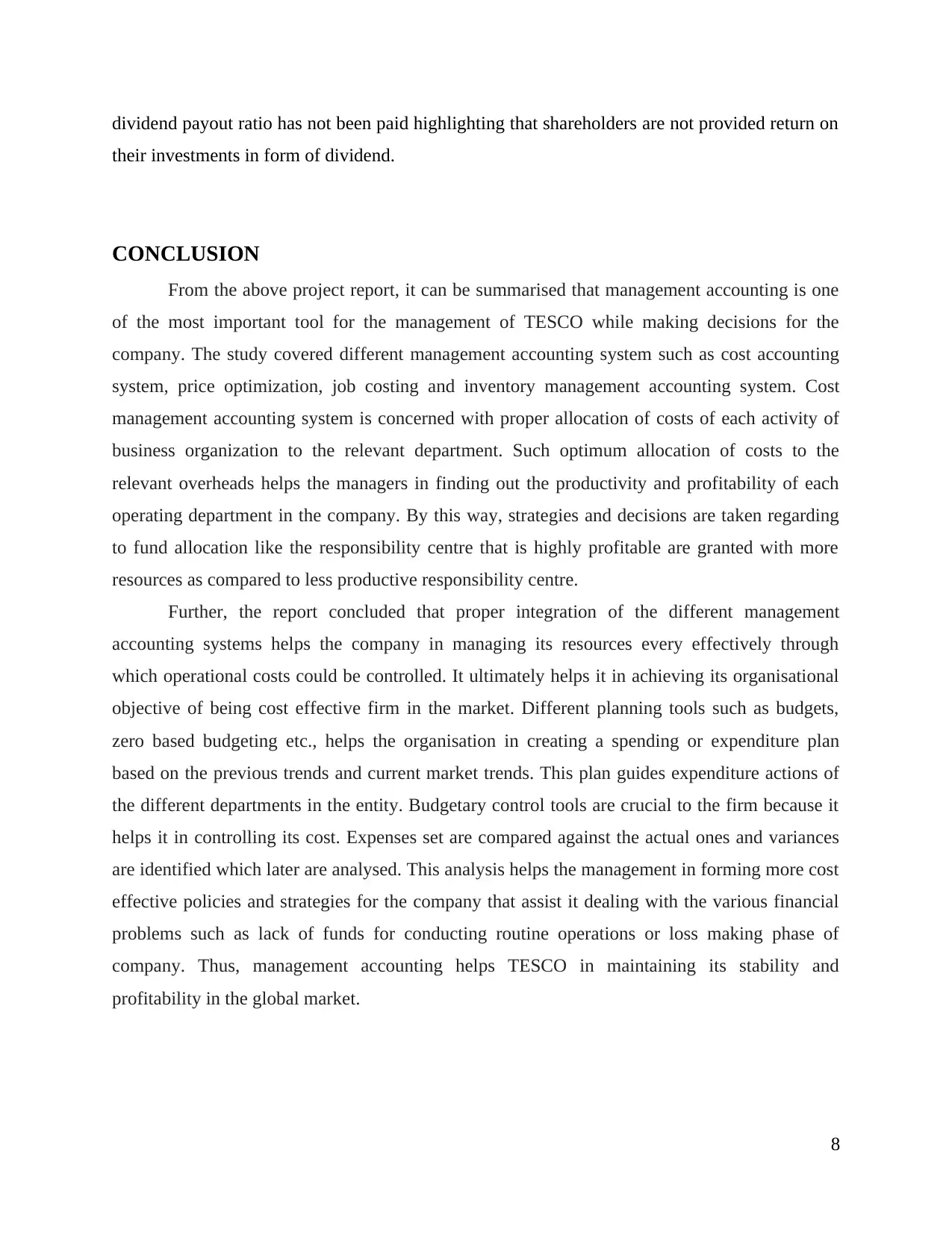
dividend payout ratio has not been paid highlighting that shareholders are not provided return on
their investments in form of dividend.
CONCLUSION
From the above project report, it can be summarised that management accounting is one
of the most important tool for the management of TESCO while making decisions for the
company. The study covered different management accounting system such as cost accounting
system, price optimization, job costing and inventory management accounting system. Cost
management accounting system is concerned with proper allocation of costs of each activity of
business organization to the relevant department. Such optimum allocation of costs to the
relevant overheads helps the managers in finding out the productivity and profitability of each
operating department in the company. By this way, strategies and decisions are taken regarding
to fund allocation like the responsibility centre that is highly profitable are granted with more
resources as compared to less productive responsibility centre.
Further, the report concluded that proper integration of the different management
accounting systems helps the company in managing its resources every effectively through
which operational costs could be controlled. It ultimately helps it in achieving its organisational
objective of being cost effective firm in the market. Different planning tools such as budgets,
zero based budgeting etc., helps the organisation in creating a spending or expenditure plan
based on the previous trends and current market trends. This plan guides expenditure actions of
the different departments in the entity. Budgetary control tools are crucial to the firm because it
helps it in controlling its cost. Expenses set are compared against the actual ones and variances
are identified which later are analysed. This analysis helps the management in forming more cost
effective policies and strategies for the company that assist it dealing with the various financial
problems such as lack of funds for conducting routine operations or loss making phase of
company. Thus, management accounting helps TESCO in maintaining its stability and
profitability in the global market.
8
their investments in form of dividend.
CONCLUSION
From the above project report, it can be summarised that management accounting is one
of the most important tool for the management of TESCO while making decisions for the
company. The study covered different management accounting system such as cost accounting
system, price optimization, job costing and inventory management accounting system. Cost
management accounting system is concerned with proper allocation of costs of each activity of
business organization to the relevant department. Such optimum allocation of costs to the
relevant overheads helps the managers in finding out the productivity and profitability of each
operating department in the company. By this way, strategies and decisions are taken regarding
to fund allocation like the responsibility centre that is highly profitable are granted with more
resources as compared to less productive responsibility centre.
Further, the report concluded that proper integration of the different management
accounting systems helps the company in managing its resources every effectively through
which operational costs could be controlled. It ultimately helps it in achieving its organisational
objective of being cost effective firm in the market. Different planning tools such as budgets,
zero based budgeting etc., helps the organisation in creating a spending or expenditure plan
based on the previous trends and current market trends. This plan guides expenditure actions of
the different departments in the entity. Budgetary control tools are crucial to the firm because it
helps it in controlling its cost. Expenses set are compared against the actual ones and variances
are identified which later are analysed. This analysis helps the management in forming more cost
effective policies and strategies for the company that assist it dealing with the various financial
problems such as lack of funds for conducting routine operations or loss making phase of
company. Thus, management accounting helps TESCO in maintaining its stability and
profitability in the global market.
8
Paraphrase This Document
Need a fresh take? Get an instant paraphrase of this document with our AI Paraphraser
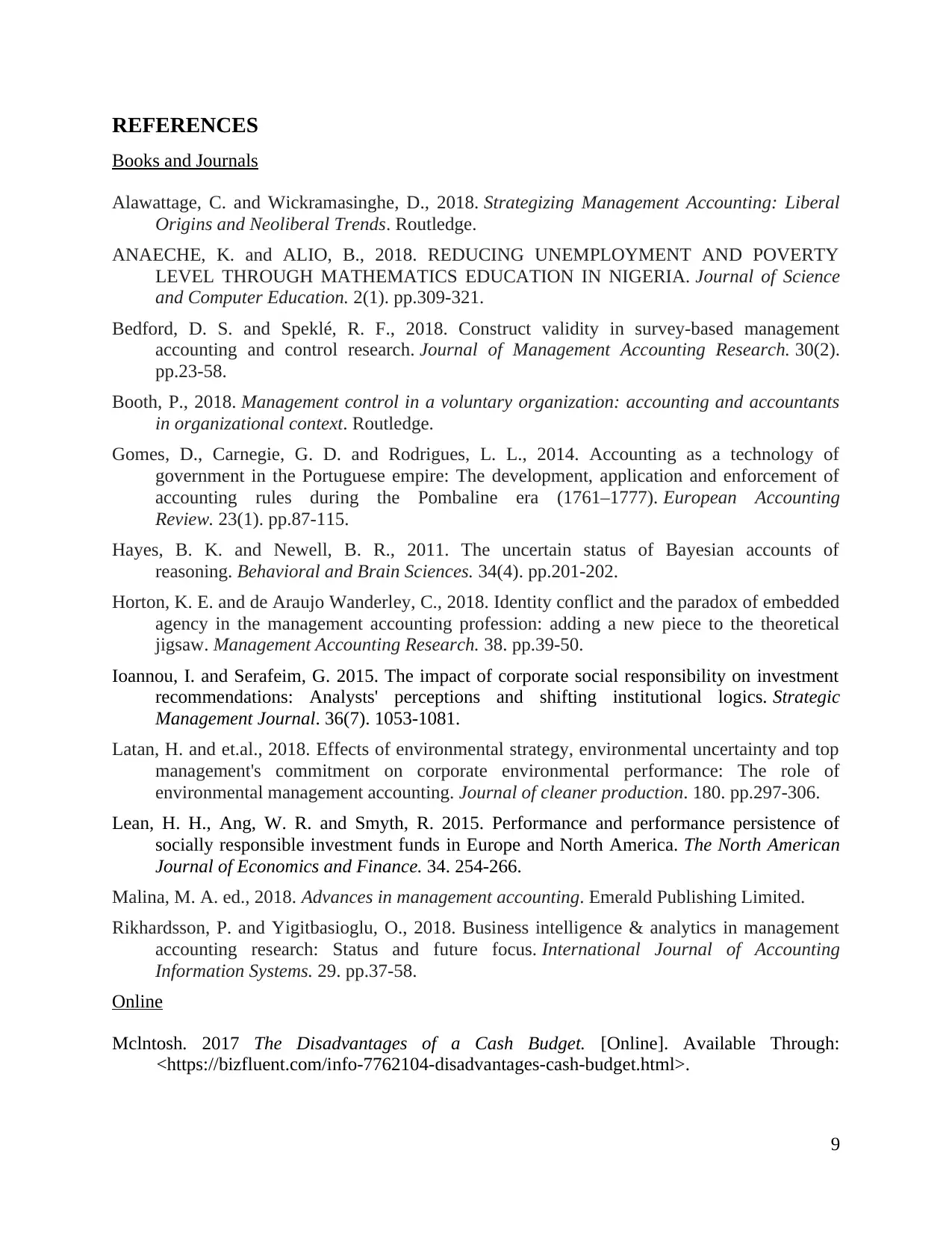
REFERENCES
Books and Journals
Alawattage, C. and Wickramasinghe, D., 2018. Strategizing Management Accounting: Liberal
Origins and Neoliberal Trends. Routledge.
ANAECHE, K. and ALIO, B., 2018. REDUCING UNEMPLOYMENT AND POVERTY
LEVEL THROUGH MATHEMATICS EDUCATION IN NIGERIA. Journal of Science
and Computer Education. 2(1). pp.309-321.
Bedford, D. S. and Speklé, R. F., 2018. Construct validity in survey-based management
accounting and control research. Journal of Management Accounting Research. 30(2).
pp.23-58.
Booth, P., 2018. Management control in a voluntary organization: accounting and accountants
in organizational context. Routledge.
Gomes, D., Carnegie, G. D. and Rodrigues, L. L., 2014. Accounting as a technology of
government in the Portuguese empire: The development, application and enforcement of
accounting rules during the Pombaline era (1761–1777). European Accounting
Review. 23(1). pp.87-115.
Hayes, B. K. and Newell, B. R., 2011. The uncertain status of Bayesian accounts of
reasoning. Behavioral and Brain Sciences. 34(4). pp.201-202.
Horton, K. E. and de Araujo Wanderley, C., 2018. Identity conflict and the paradox of embedded
agency in the management accounting profession: adding a new piece to the theoretical
jigsaw. Management Accounting Research. 38. pp.39-50.
Ioannou, I. and Serafeim, G. 2015. The impact of corporate social responsibility on investment
recommendations: Analysts' perceptions and shifting institutional logics. Strategic
Management Journal. 36(7). 1053-1081.
Latan, H. and et.al., 2018. Effects of environmental strategy, environmental uncertainty and top
management's commitment on corporate environmental performance: The role of
environmental management accounting. Journal of cleaner production. 180. pp.297-306.
Lean, H. H., Ang, W. R. and Smyth, R. 2015. Performance and performance persistence of
socially responsible investment funds in Europe and North America. The North American
Journal of Economics and Finance. 34. 254-266.
Malina, M. A. ed., 2018. Advances in management accounting. Emerald Publishing Limited.
Rikhardsson, P. and Yigitbasioglu, O., 2018. Business intelligence & analytics in management
accounting research: Status and future focus. International Journal of Accounting
Information Systems. 29. pp.37-58.
Online
Mclntosh. 2017 The Disadvantages of a Cash Budget. [Online]. Available Through:
<https://bizfluent.com/info-7762104-disadvantages-cash-budget.html>.
9
Books and Journals
Alawattage, C. and Wickramasinghe, D., 2018. Strategizing Management Accounting: Liberal
Origins and Neoliberal Trends. Routledge.
ANAECHE, K. and ALIO, B., 2018. REDUCING UNEMPLOYMENT AND POVERTY
LEVEL THROUGH MATHEMATICS EDUCATION IN NIGERIA. Journal of Science
and Computer Education. 2(1). pp.309-321.
Bedford, D. S. and Speklé, R. F., 2018. Construct validity in survey-based management
accounting and control research. Journal of Management Accounting Research. 30(2).
pp.23-58.
Booth, P., 2018. Management control in a voluntary organization: accounting and accountants
in organizational context. Routledge.
Gomes, D., Carnegie, G. D. and Rodrigues, L. L., 2014. Accounting as a technology of
government in the Portuguese empire: The development, application and enforcement of
accounting rules during the Pombaline era (1761–1777). European Accounting
Review. 23(1). pp.87-115.
Hayes, B. K. and Newell, B. R., 2011. The uncertain status of Bayesian accounts of
reasoning. Behavioral and Brain Sciences. 34(4). pp.201-202.
Horton, K. E. and de Araujo Wanderley, C., 2018. Identity conflict and the paradox of embedded
agency in the management accounting profession: adding a new piece to the theoretical
jigsaw. Management Accounting Research. 38. pp.39-50.
Ioannou, I. and Serafeim, G. 2015. The impact of corporate social responsibility on investment
recommendations: Analysts' perceptions and shifting institutional logics. Strategic
Management Journal. 36(7). 1053-1081.
Latan, H. and et.al., 2018. Effects of environmental strategy, environmental uncertainty and top
management's commitment on corporate environmental performance: The role of
environmental management accounting. Journal of cleaner production. 180. pp.297-306.
Lean, H. H., Ang, W. R. and Smyth, R. 2015. Performance and performance persistence of
socially responsible investment funds in Europe and North America. The North American
Journal of Economics and Finance. 34. 254-266.
Malina, M. A. ed., 2018. Advances in management accounting. Emerald Publishing Limited.
Rikhardsson, P. and Yigitbasioglu, O., 2018. Business intelligence & analytics in management
accounting research: Status and future focus. International Journal of Accounting
Information Systems. 29. pp.37-58.
Online
Mclntosh. 2017 The Disadvantages of a Cash Budget. [Online]. Available Through:
<https://bizfluent.com/info-7762104-disadvantages-cash-budget.html>.
9
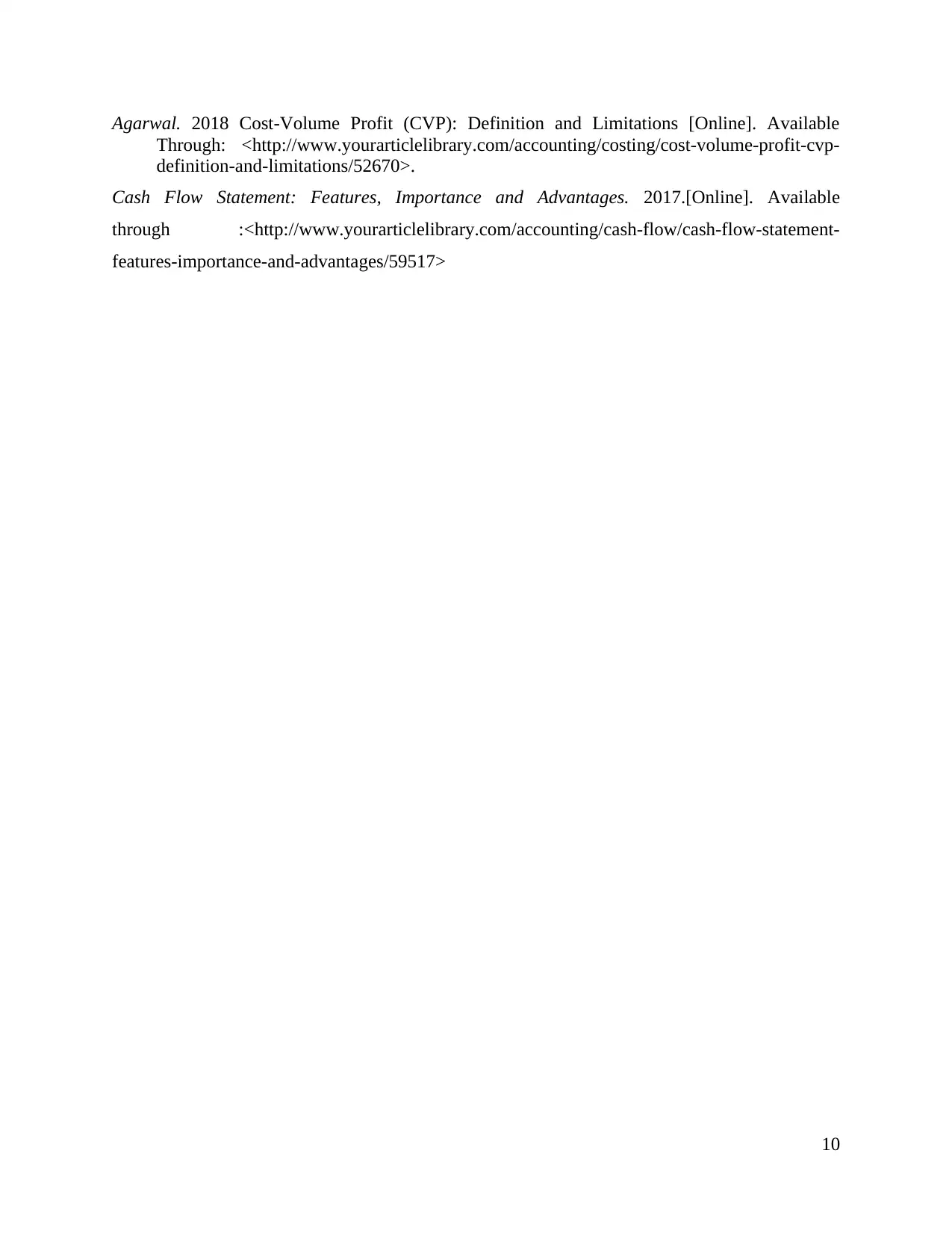
Agarwal. 2018 Cost-Volume Profit (CVP): Definition and Limitations [Online]. Available
Through: <http://www.yourarticlelibrary.com/accounting/costing/cost-volume-profit-cvp-
definition-and-limitations/52670>.
Cash Flow Statement: Features, Importance and Advantages. 2017.[Online]. Available
through :<http://www.yourarticlelibrary.com/accounting/cash-flow/cash-flow-statement-
features-importance-and-advantages/59517>
10
Through: <http://www.yourarticlelibrary.com/accounting/costing/cost-volume-profit-cvp-
definition-and-limitations/52670>.
Cash Flow Statement: Features, Importance and Advantages. 2017.[Online]. Available
through :<http://www.yourarticlelibrary.com/accounting/cash-flow/cash-flow-statement-
features-importance-and-advantages/59517>
10
⊘ This is a preview!⊘
Do you want full access?
Subscribe today to unlock all pages.

Trusted by 1+ million students worldwide
1 out of 16
Related Documents
Your All-in-One AI-Powered Toolkit for Academic Success.
+13062052269
info@desklib.com
Available 24*7 on WhatsApp / Email
![[object Object]](/_next/static/media/star-bottom.7253800d.svg)
Unlock your academic potential
Copyright © 2020–2025 A2Z Services. All Rights Reserved. Developed and managed by ZUCOL.




